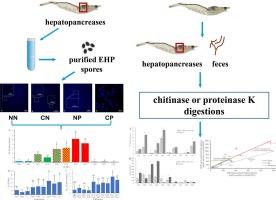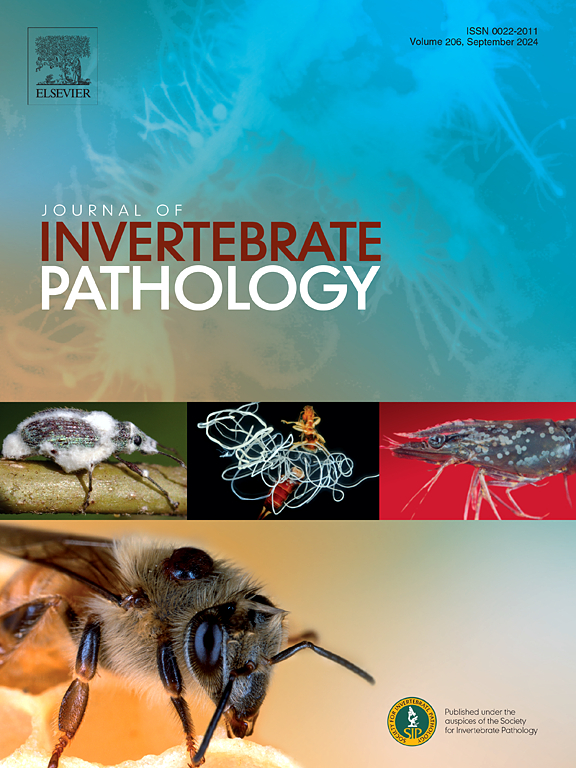Chitinase and proteinase K treatments enhance the DNA yield of microsporidium Ecytonucleospora hepatopenaei spores
IF 2.4
3区 生物学
Q1 ZOOLOGY
引用次数: 0
Abstract
Microsporidium Ecytonucleospora hepatopenaei (EHP) spores were purified from the hepatopancreas of Penaeus vannamei infected with EHP by percoll density gradient centrifugation and differential centrifugation. The EHP spores contain a thick chitin wall and might not rupture using the routine DNA extraction protocol. In this study, three enzymes were used, including chitinase, proteinase K, and DNase I. Chitinase or proteinase K digestions caused weakened fluorescence of chitin showing by a blurred edge of EHP spores stained with calcofluor white under a fluorescence microscope. Different combinations of these enzymes followed by DNA extraction with phenol–chloroform from EHP spores showed significant increases in the copy number of the EHP SSU gene per spore. The combination of the chitinase and proteinase K treatments resulted 4.46 ± 1.07 copies/spore detected, which is 31.6 ± 20.7 folds of no treatment groups, accounting to (55.7 ± 13.4)% of the total copies of the gene in the spore. The additional treatment with chitinase to the conventional extraction protocol with a proteinase K digestion step for feces and hepatopancreas samples of P. vannamei resulted in a significant difference in EHP copies in the DNA of (83.8 ± 64.1)% and (55.3 ± 88.0)% increases. The study proved that chitinase and proteinase K treatment enhance the DNA extraction from microsporidian spores resulting in high yield.

几丁质酶和蛋白酶 K 处理可提高肝孢子虫小孢子的 DNA 产量。
通过 percoll 密度梯度离心法和差速离心法,从感染了 EHP 的万年青(Penaeus vannamei)肝胰腺中纯化了 Ecytonucleospora hepatopenaei(EHP)小孢子。EHP 孢子含有厚厚的几丁质壁,常规的 DNA 提取方案可能无法使其破裂。甲壳素酶或蛋白酶 K 可使甲壳素的荧光减弱,在荧光显微镜下,用钙氟白染色的 EHP 孢子边缘模糊不清。用酚-氯仿从 EHP 孢子中提取 DNA 后,这些酶的不同组合显示每个孢子的 EHP SSU 基因拷贝数显著增加。几丁质酶和蛋白酶 K 组合处理的结果是每孢子检测到 4.46 ± 1.07 个拷贝,是未处理组的 31.6 ± 20.7 倍,占孢子中该基因总拷贝数的(55.7 ± 13.4)%。在对凡纳滨贝类粪便和肝胰腺样本进行蛋白酶 K 消化步骤的常规提取方案的基础上,再使用几丁质酶处理,结果发现 DNA 中的 EHP 拷贝数有显著差异,分别增加了(83.8 ± 64.1)%和(55.3 ± 88.0)%。该研究证明,几丁质酶和蛋白酶 K 处理可提高微孢子虫孢子的 DNA 提取率,从而获得高产率。
本文章由计算机程序翻译,如有差异,请以英文原文为准。
求助全文
约1分钟内获得全文
求助全文
来源期刊
CiteScore
6.10
自引率
5.90%
发文量
94
审稿时长
1 months
期刊介绍:
The Journal of Invertebrate Pathology presents original research articles and notes on the induction and pathogenesis of diseases of invertebrates, including the suppression of diseases in beneficial species, and the use of diseases in controlling undesirable species. In addition, the journal publishes the results of physiological, morphological, genetic, immunological and ecological studies as related to the etiologic agents of diseases of invertebrates.
The Journal of Invertebrate Pathology is the adopted journal of the Society for Invertebrate Pathology, and is available to SIP members at a special reduced price.

 求助内容:
求助内容: 应助结果提醒方式:
应助结果提醒方式:


